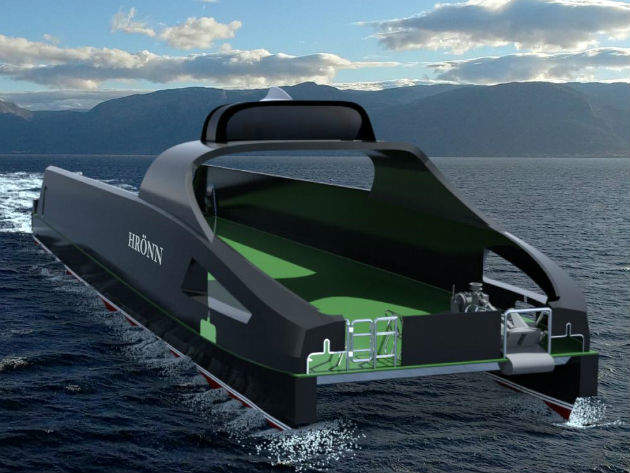

It all started around three years ago, in response to what Brett Phaneuf, managing director of Automated Ships, believes has been a lack of material progress in automation.
"One of the things I've been concerned about is that there are a lot of these small systems out there, but they can't do that much,” he says. “They're quite capable as small vehicles, but when it comes to doing any substantive [work] offshore, they don't have the stability, stamina or payload.”
Phaneuf hopes the answer will be the Hrönn, marketed as the world's first unmanned and fully automated vessel for offshore operations. Developed in collaboration with Kongsberg Maritime, the light-duty utility ship will initially operate as a remotely piloted vehicle, before moving to fully autonomous operations at an unspecified date.
Phaneuf explains: “We've gone through a few designs. I would say one of the things we've realised is that [the design] can be troublesome.
“Once you solve the problem about how you will automate the ship – the software, hardware, firmware – the ship itself kind of becomes secondary. So, which one do you build first? It depends on what you want to do with it.”

US Tariffs are shifting - will you react or anticipate?
Don’t let policy changes catch you off guard. Stay proactive with real-time data and expert analysis.
By GlobalDataThe project team hopes that a final design will be confirmed early this year, followed by construction sometime around April. The Hrönn will hit the water in April next year and undergo sea trials in Norway's automated vessel test bed in the Trondheimsfjord area. It could be available for service later in 2018.
What will the Hrönn do?
The main objectives and responsibilities of the Hrönn will be in the offshore energy, scientific/hydrographic, and offshore fish-farming industries. Possible uses include operating as a remotely operated vehicle (ROV) and autonomous underwater vehicle (AUV) for survey purposes; delivery to offshore installations; and open-water fish farm support. “We will target the easier things first; the low-hanging fruit,” says Phaneuf.
“[It could also be used] as a standby vessel, able to provide firefighting support to an offshore platform, working in cooperation with manned vessels,” says Tom Eystø, vice president of offshore at Kongsberg Maritime.
So, is the Hrönn a response to specific industry needs and desires, or simply the next step as technology advances? “I would say a little bit of both,” explains Eystø, “but technology is the enabler.”
However, the downturn in oil and gas has created the conditions in which people are increasingly open to new ideas, according to Phaneuf. “It’s a good time for us to come in,” he adds, as offshore operators are thinking “how do we reduce costs and drive innovation”?
When asked about the potential cost of the Hrönn, Phaneuf is reluctant to reveal a definitive figure, but adds that it’s “less expensive than, say, building another [manned] ship its size”. He continues: “We've relieved it of everything it would require to sustain life at sea. It's purely a machine.”
This machine will start life in what is known as the man-in-the-loop mode, essentially something that requires human interaction, or direct remote control. However, it will transition to fully automated and ultimately autonomous operations as the necessary algorithms are developed. “Unmanned is a vision,” says Eystø.
Phaneuf confirms they could go significantly more autonomous at the outset, but they want to reassure nervous minds first. “We want people to have confidence that the ship is safe and can do certain tasks,” he says. “What I'm after is a level of autonomy, but first automation, then autonomy. [We want] predictable, deterministic behaviour.”
He describes this as the slowly-and-when-appropriate method. “The answer isn't getting rid of people, it's [about] taking people onshore and reducing exposure and liability,” he adds.
Testing the waters
The Hrönn is certainly an ambitious project. There are already plans for a second ship, and possibly a third on the books sometime in next few years. Phaneuf says that, in theory, up to five could be built, but a firmer plan will emerge once the first has proven itself out at sea and after clients have been consulted. “Technology-wise, everything is there. I really think this is just a matter of will,” states Phaneuf.
The design and specifications of future vessels might change, however, after the relevant teams have time to digest test results and performance. Phaneuf believes it will be hard to predict in what direction the market will head, but “there's no way to predict that without actually giving it a try”.
“Lots of people are talking about the market, what resistance there might be, and so on, but we just have to give it a try,” he adds.
What of the reaction from industry? Both Phaneuf and Eystø claim it has been, on the whole, very positive. “Everyone wants somebody to jump off a cliff, so it might as well be us. Fortunately we'll be landing in the ocean, so that's a good start,” jokes Phaneuf.
But of course, the idea of autonomy does produce some resistance. “There's the usual 'it's too complicated, it will never work' [argument],” Phaneuf says, “but you point out how complicated shipping is now. We will slow-walk into autonomy through automation.”
DNV GL and the Norwegian Maritime Authority will work with the Hrönn team on regulatory matters. “We should be well prepared for adapting to rules and regulations,” says Eystø, and the vessel will be classed and flagged at a later date.
In the meantime, eyes turn to April and then to 2018, as the Hrönn moves from concept design to what could be the standard bearer for autonomous offshore vessels.



